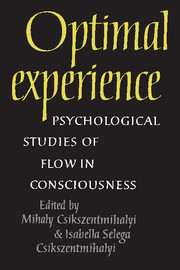Book contents
- Frontmatter
- Contents
- Acknowledgments
- Contributors
- I A THEORETICAL MODEL OF OPTIMAL EXPERIENCE
- II VARIETIES OF THE FLOW EXPERIENCE
- 5 Introduction to Part II
- 6 Bosozoku: flow in Japanese motorcycle gangs
- 7 Women, work, and flow
- 8 The relationship between life satisfaction and flow in elderly Korean immigrants
- 9 Flow and writing
- 10 Flow in solitary ordeals
- III FLOW AS A WAY OF LIFE
- IV THE MEASUREMENT OF FLOW IN EVERYDAY LIFE
- References
- Name index
- Subject index
6 - Bosozoku: flow in Japanese motorcycle gangs
Published online by Cambridge University Press: 05 June 2012
- Frontmatter
- Contents
- Acknowledgments
- Contributors
- I A THEORETICAL MODEL OF OPTIMAL EXPERIENCE
- II VARIETIES OF THE FLOW EXPERIENCE
- 5 Introduction to Part II
- 6 Bosozoku: flow in Japanese motorcycle gangs
- 7 Women, work, and flow
- 8 The relationship between life satisfaction and flow in elderly Korean immigrants
- 9 Flow and writing
- 10 Flow in solitary ordeals
- III FLOW AS A WAY OF LIFE
- IV THE MEASUREMENT OF FLOW IN EVERYDAY LIFE
- References
- Name index
- Subject index
Summary
A recurrent feature of most societies is tension between the generations, a tension that often finds expression in more or less open, more or less ritualized conflict between youth and their elders. This conflict has been said to be directly proportional to the rapidity of social change and to the amount of new information unavailable to their elders that each new generation must assimilate (Davis 1940). Japan is no exception to this trend. At least since the end of World War II, youth movements of various sorts have expressed, in various forms of ritually organized behavior, a departure from the goals and norms of adult Japanese society.
Perhaps one of the most visible of such forms has been juvenile motorcycle gangs, particularly the bosozoku groups, which include mainly young men between 15 and 21 years of age. The term bosozoku means “violent-driving tribe” or “out-of-control tribe,” and the name implies the character image that both group members and outsiders assign to participants in the so-called runs that are the most important activity of the groups. The number of individuals associated with bosozoku gangs rose from about 12,500 in 1973 to about 39,000 members with some 24,000 vehicles in 1983 (Keisatsucho 1981; Homusho 1983). During the same period the number of arrests associated with their activities increased from 28,000 to 54,819 cases, which included 48,278 traffic and 6,541 criminal citations (Keisatsucho 1981, 1983, 1984).
- Type
- Chapter
- Information
- Optimal ExperiencePsychological Studies of Flow in Consciousness, pp. 92 - 117Publisher: Cambridge University PressPrint publication year: 1988
- 34
- Cited by



